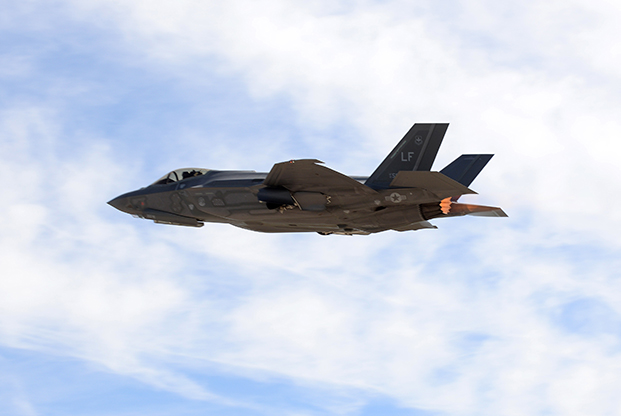
An F-35A Lightning II flies over Luke AFB, Ariz., on Oct. 31. ?Air Force photo by SSgt. Franklin Ramos.
The F-35 Joint Strike Fighter has officially entered Initial Operational Test and Evaluation, a major program milestone that, when successfully completed, will pave the way for full-rate production of the Lightning II, which is already operating with three US services and six foreign air forces. The IOT&E effort is set to conclude in “late summer, 2019.”
The milestone comes some 17 years after the F-35 was selected to serve as the principal new combat airplane for the Air Force, Marine Corps, and Navy. Nine partner nations have helped co-develop the aircraft, and several countries have purchased it under the Foreign Military Sales program.
Some elements of the evaluation started earlier this year, to save time, the Joint Program Office said. These “pre-IOT&E” evaluations included cold weather testing, weapons demonstrations, “suitability deployments” aboard ships, and “lower-threat missions.”
The new effort, under the Pentagon’s Director, Operational Test and Evaluation, will put the jet through its paces to measure “the effectiveness, suitability, lethality, survivability, and overall mission capability” of the F-35 weapons system. It will be “field tested under realistic combat conditions” and be graded on tests such as combat effectiveness, weapons accuracy, and maintainability under deployed conditions. The testing will take place on US military ranges and installations against representative threats.
It is typical that IOT&E reveals flaws and shortcomings in new systems; test pilots invariably rate new aircraft as “unsuitable” until all the bugs have been worked out. The JPO said the DOT&E will “analyze the data from the testing and prepare a report for Congress and the Secretary of Defense evaluating the results and adequacy of the test.” The F-35 “enterprise” will work to “understand and holistically address any findings.” Once that’s all done, the jet can advance to the “Milestone C” point, at which it can enter full-rate production. After that, multi-year buys can commence to further reduce the cost of the aircraft, now slated to be under $80 million a copy for the F-35A by 2020.
The Marine Corps declared initial operational capability with the F-35B—the short takeoff/vertical landing variant—in 2015. The Air Force declared IOC with the conventional takeoff/landing F-35A version a year later, and both services have operated the fighter on overseas deployments. The Marine Corps version has flown some combat missions and released weaponry in Afghanistan, as well.
Italy declared IOC with its F-35s on Nov. 30, while Britain plans to make its operational declaration by the end of this month.
However, both services declared IOC with a not-yet-fully developed version of the fighter. The configuration to be tested in IOT&E is the Block 3F, or baseline version, with all the weapons capability, electronic warfare, software, self-protection, maintenance, and other capabilities promised for the first all-up models. Development of Block IV upgrades, which will be back-fitted to earlier jets and be incorporated into the future production line, are already being mapped out.
The Navy is expected to declare IOC with its carrier-capable version, the F-35C, by the end of February, 2019, although recently the service has suggested that date may slip.
“The start of formal operational testing is a milestone more than 18 years in the making,” Program Executive Officer Vice Adm. Mat Winter said in a press statement. “It is the culmination of years of hard work and dedication from the government and industry team who completed the most comprehensive, rigorous, and … safest developmental flight test program in aviation history.” Even while IOT&E is underway, the JPO “will continue to support the delivery of phased capability improvements and modernization of the air system.
Lockheed Martin has produced more than 340 F-35s of all three types. Only one aircraft, an F-35B, has crashed since the inception of the program. The Air Force plans to build 1,763 F-35s, and all US services jointly plan to buy nearly 2,400 of the jets.
SEE ALSO: Clear of the Turbulence From the August 2017 issue of Air Force Magazine.
